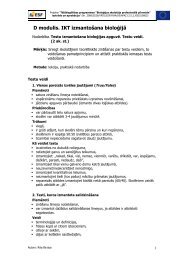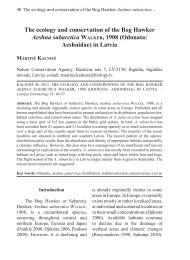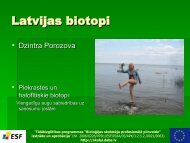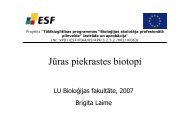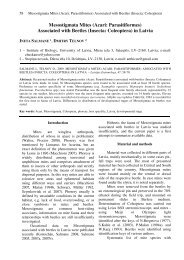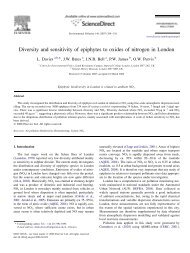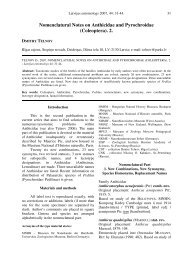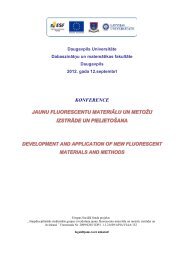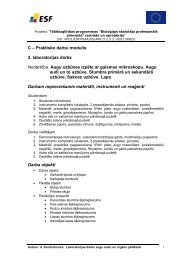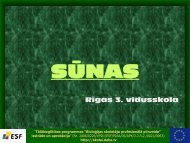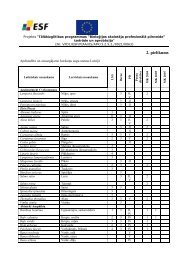Odonata - Entomological Society of Latvia - Latvijas Daba
Odonata - Entomological Society of Latvia - Latvijas Daba
Odonata - Entomological Society of Latvia - Latvijas Daba
Create successful ePaper yourself
Turn your PDF publications into a flip-book with our unique Google optimized e-Paper software.
suitability <strong>of</strong> a habitat is characterized more by the vegetation, rather than its origin (natural vs.<br />
man-made).<br />
L. caudalis in <strong>Latvia</strong> is mostly found in eutrophic lakes (51 %), less frequently in oxbows<br />
(18 %) and dystrophic lakes (16 %). This is accounted by the fact that the species generally prefers<br />
habitats with rich under-water (Potamogetonetea – type vegetation) vegetation and, unlike other<br />
Leucorrhinia species, can survive in water bodies with high density <strong>of</strong> fish (Mauersberger, Heinrich<br />
1993; Dijkstra 2006). Nevertheless, Bernard et al. (2002) notes that the species inhabits water<br />
bodies with low trophia and with the growing <strong>of</strong> trophia, the species may diminish and fully<br />
disappear from the specific water body. Rather frequently the species has been found in oxbows,<br />
although this is more characteristic to the periphery <strong>of</strong> the distribution area and is less popular<br />
habitat (Dijkstra 2006; Bernard et al. 2009). Several localities have been found in old peat quarries<br />
with well developed above-water (Phragmitetea – type vegetation) and under-water<br />
(Potamogetonetea – type vegetation) vegetation.<br />
L. pectoralis, in comparison with the other two species, inhabits broader spectrum <strong>of</strong> habitats,<br />
as it can be equally <strong>of</strong>ten found in eutrophic (26 %) and dystrophic (25 %) lakes and oxbows<br />
(32 %). This corresponds to the description <strong>of</strong> the species habitats in Europe (Dijkstra 2006). Other<br />
authors (Bernard et al 2002; Mauersberger 2010) as well note that L. pectoralis can be found in<br />
various habitats with very dynamic water regime, temperature and oxygen content. Although<br />
several authors (Wildermuth 1994; Schiel, Buchwald 1998) have mentioned that in the southern<br />
part <strong>of</strong> the species distribution area this species inhabits water bodies without fish, the latest studies<br />
show that the species in whole area inhabits water bodies with fish (Mauresberger 2010; Petrin et al.<br />
2010). Similarly, in all lakes in <strong>Latvia</strong> where the species localities have been found, also the<br />
presence <strong>of</strong> fish has been observed (Birzaks 2007; Ezeri.lv 2011). In all localities <strong>of</strong> L. pectoralis in<br />
gravel quarries and old peat quarries well-developed and varied above-water (Phragmitetea - type<br />
vegetation) and under-water (Potamogetonetea – type vegetation) vegetation has been found. This<br />
shows that the suitability <strong>of</strong> a habitat is characterized more by the vegetation, rather than its origin<br />
(natural vs. man-made).<br />
The initial assumption that all three species are closely connected to the oxbows <strong>of</strong> the Gauja<br />
River was only partially confirmed. In the oxbows <strong>of</strong> the Gauja River mainly L. pectoralis was<br />
found, less frequently – L. caudalis. In all oxbows where L. caudalis was found, also L. pectoralis<br />
was observed. As L. caudalis is usually observed in a lesser extent than L. pectoralis, it is possible<br />
that the species, at least in oxbows, is more common that previously found.<br />
The amount <strong>of</strong> data obtained in Tītmaņi oxbow in 2005 allows drawing conclusions only<br />
regarding the L. pectoralis and micro habitats. The species can be found in open habitats with<br />
mainly above-water (Phragmitetea – type vegetation) vegetation. In Tītmaņi oxbow large number<br />
<strong>of</strong> individuals was found also in the sample area with under-water (Potamogetonetea – type<br />
vegetation) vegetation – a growth <strong>of</strong> water soldier Stratiotes aloides. This may be due to the fact<br />
that water soldier in the bank <strong>of</strong> Tītamaņi oxbow creates a think, floating above water vegetation<br />
transiting into a marsh. The high number <strong>of</strong> individuals in the sample area with the growth <strong>of</strong> bent<br />
grass Agrostis tenuis shows that the species may also use grass habitats near the water bodies, as<br />
long as they are not enclosed by bushes and trees. The sample areas where the species were not<br />
found were enclosed by bushes and trees (Figure 1).<br />
77



